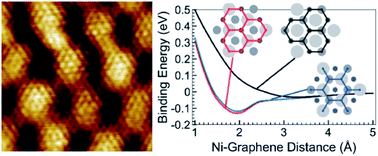Graphene–nickel interfaces: a review
Abstract
Graphene on nickel is a prototypical example of an interface between graphene and a strongly interacting metal, as well as a special case of a lattice matched system. The chemical interaction between graphene and nickel is due to hybridization of the metal d-electrons with the π-orbitals of graphene. This interaction causes a smaller separation between the nickel surface and graphene (0.21 nm) than the typical van der Waals gap-distance between graphitic layers (0.33 nm). Furthermore, the physical properties of graphene are significantly altered. Main differences are the opening of a band gap in the electronic structure and a shifting of the π-band by ∼2 eV below the Fermi-level. Experimental evidence suggests that the ferromagnetic nickel induces a magnetic moment in the carbon. Substrate induced geometric and electronic changes alter the phonon dispersion. As a consequence, monolayer graphene on nickel does not exhibit a Raman spectrum. In addition to reviewing these fundamental physical properties of graphene on Ni(111), we also discuss the formation and thermal stability of graphene and a surface-confined nickel-carbide. The fundamental growth mechanisms of graphene by chemical vapor deposition are also described. Different growth modes depending on the sample temperature have been identified in ultra high vacuum surface science studies. Finally, we give a brief summary for the synthesis of more complex graphene and graphitic structures using nickel as catalyst and point out some potential applications for graphene–nickel interfaces.


 Please wait while we load your content...
Please wait while we load your content...